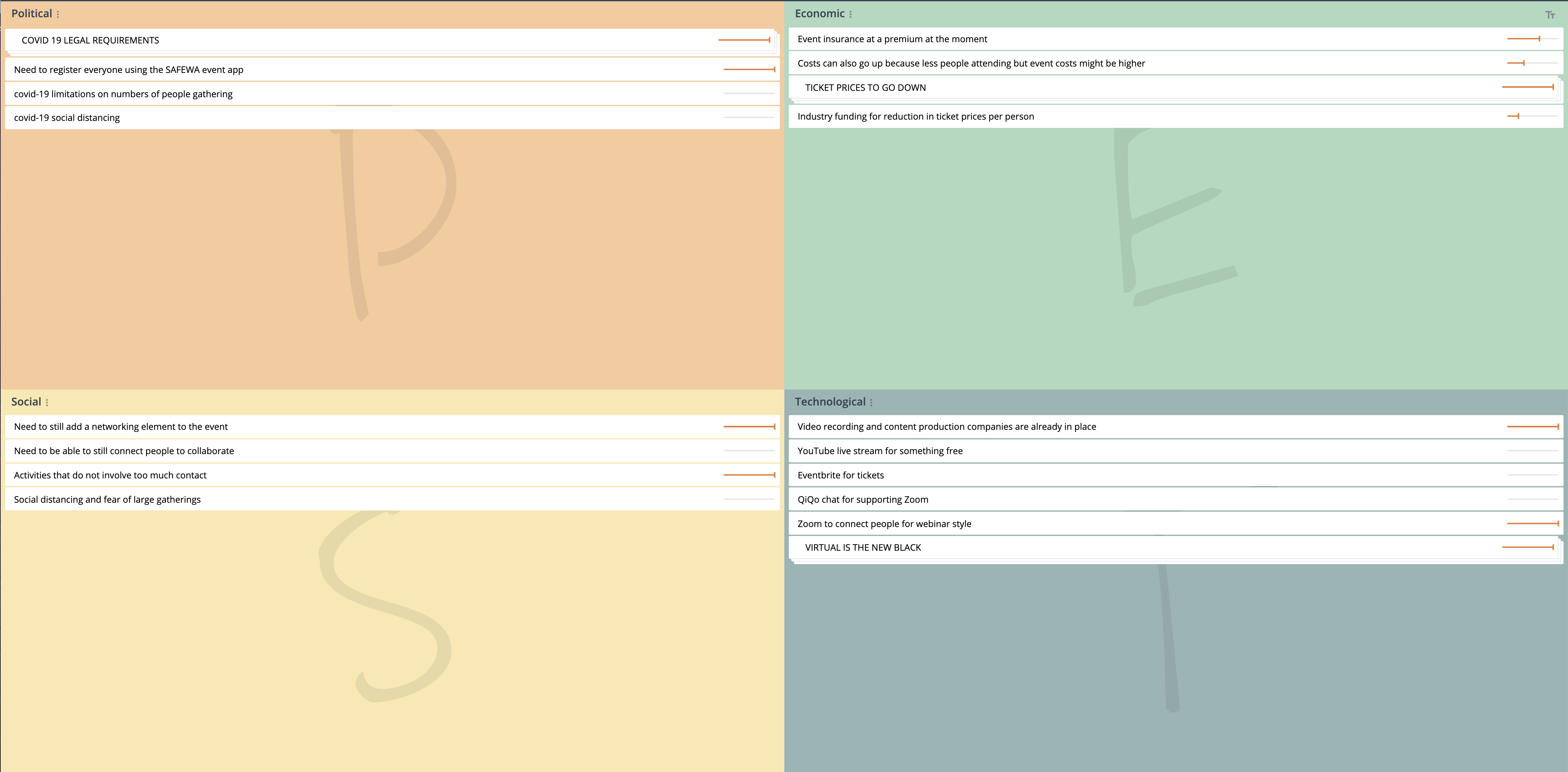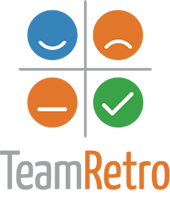
What is PEST Analysis?
A PEST analysis is a strategic business tool used by organizations to discover, evaluate, organize, and track macro-economic factors which can impact on their business now and in the future.
The framework examines opportunities and threats due to Political, Economic, Social, and Technological forces. Outputs from the analysis inform strategic planning processes and contribute to market research.
The output from a PEST analysis is useful for informing other business management processes such as SWOT analysis, SOAR analysis, risk analysis, or a Business Model Canvas.
There are many variations of this framework, which look at different external factors, depending on which industry or market the organization operates in. Examples include PESTLE, STEEPLE, STEER, and STEEP.
Why Do a PEST Analysis?
- Helps to evaluate how your strategy fits into the broader environment and encourages strategic thinking
- Provides an overview of all the crucial external influences on the organization
- Supports more decisive and knowledgeable decision making
- Assists planning, marketing, organizational change initiatives, business and product development, project management, and research papers
Who Should Use a PEST Analysis?
A PEST analysis is useful for any organization that needs to gauge current and future markets. Predominantly, this is conducted by senior management, C-levels for strategic planning purposes. External agencies, bodies, stakeholders and decision makers who may have perspectives as well as consultants and parters can also offer valuable insights into the PEST analysis.
The significance of each area in PEST Analysis will vary for different industry sectors. For example, there is likely to be a different emphasis on the technology element for IT organizations compared with those involved in health, tourism, mining, defense, and banking.
Facilitation tips in conducing a PEST Analysis
- Carefully select participants to provide expert knowledge but also a fresh perspective.
- A PEST analysis is not just about listing down political, economic, social and technological factors that you simply know or have heard of. It is also important to validate them with suitable information and rate its impact on your organization.
- Rating the impact of each factor lets you identify the most important issues.
- For complex organisations and where they are servicing multiple locations, there may need to be a PEST analysis for each environment.
- Use quantitative data where possible to focus on the crux of the issue.
- Provide adequate time in the session to rank and prioritize ideas.
- You can also have people vote or colour code factors that are temporary, long term or should be monitored over time.
- Try to keep factors relatively high level and avoid getting bogged down in analysis paralysis.
- Aguilar, Francis. 1967. “Scanning the Business Environment.” New York: The Macmillan Company. p239.
- Chartered Management Institute – Carrying out a PEST Analysis Checklist
PEST Analysis Template
Political
Examples include:
Government policy, political stability or instability, bureaucracy, corruption, competition regulation, foreign trade policy, tax policy, trade restrictions, labor/environmental/copyright/consumer protection laws, funding grants & initiatives, etc.
Questions to ask:
- What government policies or political groups could be beneficial or detrimental to our success?
- Is the political environment stable or likely to change?
Social
Examples include:
Attitudes and shared beliefs about a range of factors including money, customer service, imports, religion, cultural taboos, health, work, leisure, the environment; population growth and demographics, immigration/emigration, family size/structure, lifestyle trends, etc.
Questions to ask
- How do our customer’s beliefs and values influence their buying habits?
- How do cultural trends and human behavior play a role in our business?
Economic
Examples include:
Economic trends, growth rates, industry growth, seasonal factors, international exchange rates, International trade, labor costs, consumer disposable income, unemployment rates, taxation, inflation, interest rates, availability of credit, monetary policies, raw material costs, etc.
Questions to ask:
- What economic factors will affect us moving forward?
- How does the performance of the economy affect us at the moment?
- How are our pricing, revenues, and costs impacted by each economic factor?
Technological
Examples include:
Technology and communications infrastructure, legislation around technology, consumer access to technology, competitor technology and development, emerging technologies, automation, research and innovation, intellectual property regulation, technology incentives, etc.
Questions to ask:
- What technological advancements and innovations are available on the horizon?
- How will this technology impact on our operations?
How to Do a PEST Analysis
Analyze and consider both the current status of factors in the PEST template and how potential changes might affect the organization in the future.
Tip To get the most from the PEST technique, gather input from the participants with different perspectives. When you’re working with a large or distributed team, getting everyone together at the same time can be difficult, inconvenient, and costly. Using different technologies like video conferencing, online forms, and collaborative brainstorming software such as GroupMap can help overcome these challenges.

Brainstorm
Brainstorm ideas for each area of the PEST analysis template

Group
Review responses, and collate ideas.

Rate
Rate the ideas according to likely impact on the organization.

Share
Share the outcomes of the session to relevant stakeholders.
Brainstorm ideas related to the four PEST factors – Political, Economic, Social, and Technological. You can do the initial brainstorming as one large group or break out into smaller units and then merge the contributions to get an overview.
Online collaboration tools like GroupMap significantly reduce the amount of resources required to combine independent lists. They also make organizing and prioritizing the ideas faster and more straightforward, thus providing savings in time and effort over traditional brainstorming tools such as a whiteboard or post-it notes.
Get participants to rate each of the ideas based on the level of impact they think it will have on the organization.
Discuss any significant differences in the ratings. Get participants to explain their reasoning and ask the group to rate those ideas again if they’ve changed their mind. When everyone’s thinking on the various factors is aligned, they will recognize and understand the challenges faced by others better.
The completed PEST analysis template provides a comprehensive overview of the opportunities and threats the organization faces now and in the future. Share the outcomes with relevant stakeholders and use the report to monitor progress and as an input for future reviews.
Repeat the PEST analysis at regular intervals to stay on top of changes in your external environment and keep your strategies and plans up to date.
GroupMap automatically generates visually appealing reports and action plans in several formats for distribution, saving time and effort after the analysis.

Save Effort, Time and Money with GroupMap
GroupMap offers more than just an online digital whiteboard—it’s innovative platform is designed to enhance the quality of your team’s decisions. With features that prevent bias and make facilitation seamless, GroupMap ensures no single voice dominates and ensures productive, inclusive conversations.
Its intuitive interface is easy for anyone to use, and its scalable design supports small teams and large groups whether they are face to face or around the globe. Customisable templates and workflows keep discussions focused on objectives, helping you drive actionable outcomes each and every time.
Create your first map and invite people in to start sharing their thoughts NOW.
Experience the power of GroupMap with our FREE 14 day trial.
Your free trial gives you access to all of our features, no credit card required.
